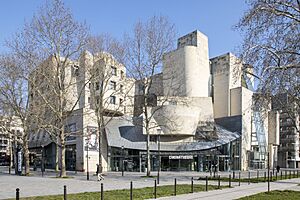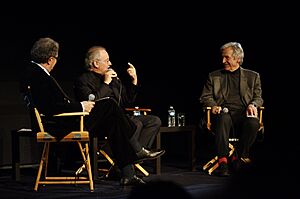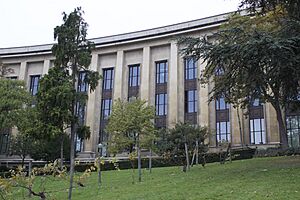Cinémathèque française facts for kids
 |
|
| Established | 1936 |
|---|---|
| Purpose | Film archive |
| Headquarters | 51, Rue de Bercy 75012 Paris, France |
| Location |
|
|
Key people
|
Henri Langlois & Georges Franju (co-founders) |
| Website | www.cinematheque.fr |
The Cinémathèque française is a special French organization. It's like a huge treasure chest for movies! Founded in 1936, it holds one of the world's largest collections of films and movie-related items.
Located in Paris, France, the Cinémathèque shows films from all over the world every day. It's a non-profit group, meaning it doesn't aim to make money. It's also the second oldest film archive in France. The oldest one is in Saint-Étienne, started in 1922.
Contents
History of the Cinémathèque
How the Collection Started
The idea for this amazing collection came from Henri Langlois and Lotte H. Eisner. They started gathering and showing films in the mid-1930s. Langlois worked hard and built one of the biggest film collections in the world.
Protecting Films During War
During World War II, German authorities in France ordered many old films to be destroyed. But Langlois and his friends were brave. They secretly moved many films and documents out of France. This saved the precious collection until the war ended.
Growth and Famous Visitors
After the war, the French government helped the Cinémathèque. They gave it a small screening room, staff, and some money. The collection moved to a new location. Many important French filmmakers of the 1940s and 1950s visited often. These included Robert Bresson and René Clément.
Later, directors from the "French New Wave" movement also learned a lot there. Filmmakers like François Truffaut and Jean-Luc Godard watched many movies at the Cinémathèque. It was like their film school!
New Leadership and Location
Over the years, the Cinémathèque had different leaders. Serge Toubiana became the general manager in 2003. Claude Berri was president from 2003 to 2007.
In 2005, the Cinémathèque moved to a new, modern building. This new home is at 51 rue de Bercy in Paris. In 2007, the Cinémathèque joined with another film organization called the BiFi. After Claude Berri, Costa-Gavras became the president. Frédéric Bonnaud took over as general manager in 2016.
The Events of May 1968
Changes and Protests
In 1963, the Cinémathèque moved to the Palais de Chaillot. The government provided money, but also started to have more control. In February 1968, the government dismissed Henri Langlois from his role. This made many people very upset.
Support for Langlois
A group of famous French filmmakers and actors quickly formed a committee to support Langlois. This group included well-known names like Jean-Luc Godard and François Truffaut. Even international filmmakers like Charles Chaplin and Stanley Kubrick showed their support. They organized protests to bring Langlois back.
Wider Unrest
These protests were not just about films. They became part of bigger demonstrations by students and young people in France. They were protesting against the government. These events grew into widespread unrest across the country in May 1968. Before that, the government gave in. They brought Henri Langlois back as the head of the Cinémathèque in April 1968.
Location of the Cinémathèque
A New Home
The Cinémathèque has moved several times over the years. It even had a fire in one of its old buildings. In 2005, it found its current home at 51, rue de Bercy. This building is in the 12th arrondissement of Paris. It was designed by a famous American architect named Frank Gehry. The building has a unique, modern look.
Museum and Library
The Cinémathèque française also includes the Musée de la Cinémathèque. This museum used to be called the Musée du cinéma Henri-Langlois. It shows the history of cinema, how films are made, and their artistic importance. The Bibliothèque du film, a library about film history, also joined with the Cinémathèque.
Leaders of the Cinémathèque

Here are some of the important people who lead the Cinémathèque:
- President: Costa-Gavras is a famous director. He has won awards like the Berlin Golden Bear and the Cannes Golden Palm.
- Director: Frédéric Bonnaud used to be a critic and a radio host.
- General Secretary: Jean-Michel Arnold has been re-elected as General Secretary since 1981. He is seen as a successor to Henri Langlois.
- Honorary Presidents:
Tributes and Appearances
Special Exhibitions
The Cinémathèque's work has been celebrated in many ways. For example, in 1970, a special event called "Cinémathèque at the Metropolitan Museum" took place in New York. It showed 70 important films over 35 evenings. Henri Langlois himself chose these films.
In Books and Movies
The Cinémathèque has also appeared in different creative works:
- It is mentioned in François Truffaut's 1968 film Stolen Kisses.
- It appears in the 2002 novel The Book of Illusions by Paul Auster.
- The 1998 song "Private Helicopter" by Harvey Danger also mentions it.
- The Cinémathèque and the events of 1968 are a big part of Gilbert Adair's 1988 novel The Holy Innocents (also known as The Dreamers). This book was also made into a 2003 film called The Dreamers.
See also
- The International Federation of Film Archives
- List of film archives
- Association des Cinémathèques Européennes - ACE (Association of European Cinematheques)
- List of works by Frank Gehry


